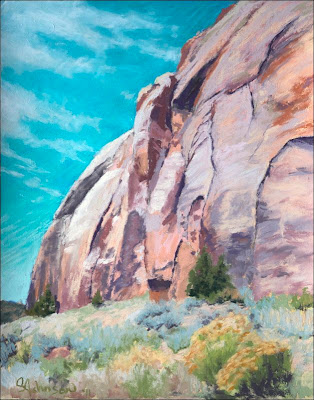tags: original pastel painting - new england landscape - beach - lighthouse - original art - oceanscape
---
I had to split this next miniseries, now switched to a 1:3 horizontal format, into two days. It's a radical change in landscape subject: coastal New England, specifically Watch Hill, RI. Watch Hill is a quaint little coastal village that is also classified as a National Historical District. It was one of my favorite places to go when we lived in Mystic, and why I ventured to paint it. I
wrote a post about it back in June, with photos taken during one of our trips there.
Napatree Beach Path
3x9 inches
pastel on reclaimed Colourfix
Napatree Point is a small barrier beach that extends west from Watch Hill, separating Block Island Sound and the Atlantic from Little Narragansett Bay. For some reason, I've always been drawn to beach paths, especially when the ocean lies out of view, like here.
Shoreline Patrol
3x9 inches
Gulls. Noisy, messy and opportunists of any unattended food, they are nonetheless an omnipresent feature of beaches everywhere. I find myself amused by them. The original photo was nothing to write home about, but this crop eliminated extraneous detail and turned it into an abstract-like design. I think this is only the second time I've ever attempted to paint an ocean shoreline (the first attempt went directly into the trash), which is probably pretty clear from this painting!
Beach Rose Fence
3x9 inches
Beach rose (Rosa rugosa) is found throughout the shoreline areas of coastal New England. Walking along the beach, I saw them covering the outside of this picket fence and thought it was so attractive and representative of the quaint nature of this charming village. The challenge here was to avoid cloning of the roses (in terms of size, shape and position) and to think in right-brained terms of everything as groups of abstract shapes, overriding the left-brain's attempt to depict them as individual roses, leaves, and formed shadows. It's about creating an impression for the viewer.
Watch Hill Lighthouse
3x9 inches
I'll be honest here...I usually detest lighthouse paintings. They conjure up images of kitsch and saccharine, Kincade-esque paintings found in touristy gift shops. The fact that this is composed of a group of buildings vs. the usual cylindrical lighthouse is what brokered the deal to photograph and then paint it. The lone gull was in the reference photo, and I decided to keep it. At least I resisted the urge to add a rose trellis up the lighthouse, eh?
All of these were done on reclaimed Colourfix paper. If I thought that painting on pristine Colourfix was unpleasant, painting on this was tedious. That I was even able to get any small shape to look like its intended form (the gull and lighthouse buildings), let alone at this small size, still surprises me.
After this, it's back to my comfort zone in the southwestern landscape for a while.





















































